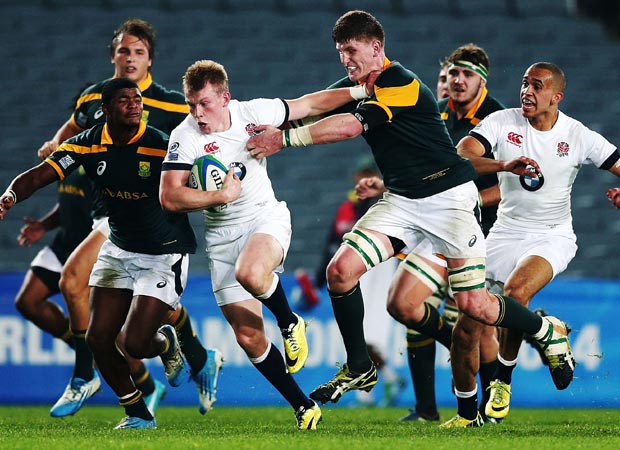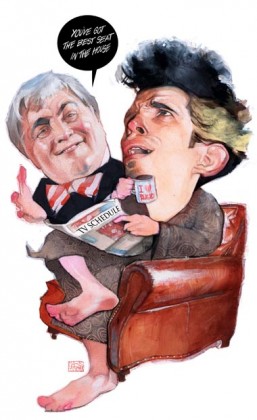 One of the most noticeable aspects of watching rugby in the Southern Hemisphere over the course of the summer has been the vast swathes of empty seats in stadiums for anything other than the biggest Test matches – and even then they are not always sell-outs.
One of the most noticeable aspects of watching rugby in the Southern Hemisphere over the course of the summer has been the vast swathes of empty seats in stadiums for anything other than the biggest Test matches – and even then they are not always sell-outs.
The crowds at the Junior World Championships held in Auckland in June were incredibly disappointing, with the New Zealand rugby public failing to engage with the tournament despite the quality of the action and the generation of young stars engaged in it.
The final, in which England and South Africa slugged it out before the Red Rose emerged with a 21-20 victory, was always riveting, and it was a poor advertisement for the sport that it was played out in front of echoing, almost empty stands, at Eden Park.
The Super 15 is another passion-free zone with half empty stadiums par for the course until it gets to the knock-out stages after 19 rounds. Attendances reflect an apathy in the support bases of the big regional franchises based in the major cities of South Africa, Australia and New Zealand.
Despite Rugby Union being part of the fabric of life in South Africa and New Zealand it is attracting a smaller live audience now than it did in 2006. In 2012 average attendances had declined by 6,000 in South Africa (34,000 to 28,000), and New Zealand (22,000 to 16,000), and by 4,000 in Australia (24,000 to 20,000).
It is not just the Southern Hemisphere which has problems. The attendances in the Premiership when Leicester, Gloucester, Northampton, Harlequins and Bath are taken out of the picture are nothing to shout about.
 The likes of Wasps, Newcastle, Sale and newly-promoted London Welsh have serious business to attend to, with average attendances of under 7,000 commonplace at all their home grounds. If you take the well-supported Irish contingent of Leinster, Munster and Ulster out of the equation the attendances in the Pro12 are stuck at a similar level. One theory for fans voting with their feet is that they get a better view of the action, with the significant benefit of instant information and analysis, if they take the short stroll to their sofa and turn on the TV – or, if they want a beverage or two with their mates while watching the match action, take the slightly longer route to their local.
The likes of Wasps, Newcastle, Sale and newly-promoted London Welsh have serious business to attend to, with average attendances of under 7,000 commonplace at all their home grounds. If you take the well-supported Irish contingent of Leinster, Munster and Ulster out of the equation the attendances in the Pro12 are stuck at a similar level. One theory for fans voting with their feet is that they get a better view of the action, with the significant benefit of instant information and analysis, if they take the short stroll to their sofa and turn on the TV – or, if they want a beverage or two with their mates while watching the match action, take the slightly longer route to their local.
This is a persuasive explanation because, while you cannot replicate the “I was there” match-day experience when there is a crackling atmosphere between two arch rivals, it lags miles behind the broadcast version if you actually want to know what's going on.
The advantage of having multiple television cameras is that they pick up on what is happening, both on the ball and off it. They can then replay it, and, while the live audience is in the dark, a major controversy could be up and running.
The main antidote to this is if there are sufficient numbers of big screens at the ground to keep the crowd informed. That is not the case at the majority of grounds – and there are other distractions. Everyone in the stadium is subjected to a constant barrage of marketing guff over the PA system from stadium announcers, or failing that, it's common currency to be blasted by ‘Muzak' anthems at every lull in play.
The chances of getting any clear information or analysis of TMO decisions or controversial refereeing decisions in such circumstances is near impossible. Even the welcome innovation of ‘ref-links' do not fill in the gaps adequately, mainly because the referee's explanations to the players are often terse and truncated.
The idea that fans inside a stadium can tune into the broadcast platform on their smart phones is also flawed because, more often than not, the Wi-Fi reception at grounds is either poor or overloaded by the volume of traffic in a confined area.
Meanwhile, the slo-mo replays on TV and the array of pundits in the line-ups of broadcasters like Sky, the BBC, or BT Sport, have delivered line, verse and chapter verdicts to keep the army of Armchair Joes ahead of the game – and ahead of those fans who have shelled-out at the gate.
It is time that the match-day experience of Rugby Union fans around the globe was enhanced by the clubs/provinces that they support looking after them better. Cut out the blather and the hard-sell over the PA and put in enough big screens so that everyone in the ground can see them. If a ruling is not self-evident, then give clear, concise, non-prejudicial summaries of refereeing and TMO decisions as soon after the incident as possible. Either use retired referees for this purpose or wire up the TMO to speak over the PA system.
Other than that, and making safety announcements, or briefly welcoming people to the ground or bidding them farewell, adhere to the principle that outside the match-action less is more.
There is little doubt that broadcasting success in Rugby Union has inherent contradictions. The biggest of these is that while you may be reaching a wider audience which prefers to get its rugby experience in the comfort of its own home, the crowd which generates the atmosphere that television feeds off may also be heading home to turn-on and tune-in.
*This article was first published in The Rugby Paper on July 27.


























